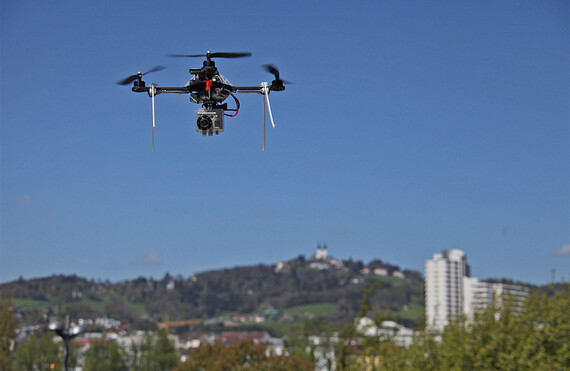Drones are so futuristic and visually compelling, so unfamiliar, that the bar for what we consider true innovation seems to be losing altitude. A drone is a remarkable piece of technology, even a small one, but this doesn't always translate into innovative applications.
One thing is true, though: A drone is only as good or bad as the work it is made to perform.
We are at a critical early stage in the integration of drones into civilian and commercial life. In 2015, the Federal Aviation Authority will open U.S. airspace to commercial and private Unmanned Aerial Systems. There are serious logistical and policy challenges ahead, and the successful negotiation of those challenges depends on how we choose to use these technologies.
One major problem is the sensationalism and confusion that has accompanied the social spillover of drones from their recent applications in war. U.S. Senator Rand Paul filibustered the nomination of CIA Director John Brennan over fears that drones would be used to kill American citizens on domestic soil. Since then, Sen. Paul essentially reversed course, stating that drones are an appropriate tool of law enforcement.
Journalist Conor Friedersdorf wrote in The Atlantic how "horrified" he was that deadly insect-sized drones might swarm urban environments. And former Navy pilot turned professor Michael S. Lewis opined that military drones are better than the tactical alternatives, though recent data indicate that strikes by manned aircraft cause fewer civilian casualties. The complex and polemical nature of the public debate about drones has made it very difficult to discuss the issue in a productive way.
It is telling that the newness of drones has been exploited for successful viral marketing campaigns. The international pizza slingers at Domino's received a great deal of attention earlier this year when they unveiled plans for a pizza delivery drone. The "Domicopter" was a publicity stunt, but it is not entirely a joke. Soon after, Yo Sushi began testing a drone for serving food to customers in its London restaurant. More recently, a Pennsylvania dry cleaners announced that it would begin delivering clean clothes with a drone.
These applications of drone technology have captured the public's imagination, and many seem eager to buy into the futuristic prospect of having a multi-rotor helicopter deliver pressed slacks or other services.
And yet, the idea of drones flying overhead is deeply unpopular. At least 35 U.S. states are at some stage of developing drone regulation laws. Several cities have already gone so far as to completely ban unmanned aerial vehicles. The improper use of drones may harm the prospects of reasonable regulation. Each time that a drone is used in a harmful or superfluous way, the movement against domestic drones of all kinds will gain traction. This trend will continue unless drones are used for beneficial, innovative applications.

CREDIT: Israel Defense Forces (CC).
Drones are already being used in ways that have prompted skepticism among lawmakers. There are paparazzi drones flying over the French Riviera, and in May a Seattle man claimed to be conducting "research" when it was discovered that he had been using a multi-rotor drone to spy on his neighbor through her apartment window. Also in development is the MeCam, a small, camera-equipped drone that follows its owner, captures images, and uploads them directly to social media profiles.
In addition to the legislative challenges to unmanned aerial technology, there are many pressing unanswered questions about how drones will coexist with each other and with other aircraft. The Government Accountability Office released a report in February 2013 showing that the Federal Aviation Authority is still struggling to develop systems for safe air-traffic management in airspace traversed by manned and unmanned aircraft.
The biggest challenge for the FAA will be managing aircraft that come in a much greater variety of shapes and sizes than manned aircraft—drones vary from small, $500 hobbyist quadcopters all the way up to 737-sized cargo planes. NASA, the FAA, and the military are all working to develop "sense and avoid" technologies that would help to prevent drones from colliding with manned aircraft or each other, but they still have a long way to go.
The FAA has already started to encounter resistance to its efforts to properly integrate drones into U.S. airspace. This week, the U.S. Senate is considering a bill that would put a halt on the FAA's efforts to integrate UAVs into domestic airspace, pending a study about "privacy concerns" related to drones.
Each step of the UAV integration process will be met with some form of opposition. In order to monitor the smaller drones that fly at low altitudes, the agency has proposed legislation that would grant it power to manage airspace just a few inches above the ground. The city of Northampton, Massachusetts raised a formal objection, in the form of a bill, to the proposed legislation, arguing that it conflicts with personal property rights (technically, under the new legislation, by growing a tall tree in your backyard, you would be interfering with "navigable" airspace).
The integration of drone technology into civilian life will be driven by big commercial interests. It is important to consider the kinds of drone uses that will constitute the greatest part of domestic drone traffic. Earlier this year, the Association for Unmanned Vehicle Systems International (AUVSI) released a report detailing the economic impact of the integration of unmanned aerial systems into U.S. industry. The report identified large-scale agriculture as the primary predicted market for drone use. Drones can be used for surveying crop damage, estimating yields, and, crucially, spraying pesticides. The drones that will be used in agriculture will remain largely outside of the public eye, and yet they will be key in determining the future of domestic drone use.
For the most part, agricultural drones do the same work as crop-duster planes or manual laborers. When drones are used for tasks that are currently carried out by other means, they do not fundamentally change the system; the nature of the task remains the same.
What drones do for agriculture is save a lot of money. As a spokesman for Volt Aerial Robotics, a manufacturer of agricultural drones, put it, even a 1 percent yield increase could generate billions of dollars in savings for the agricultural sector, a gain predicted to be easily achievable with drone technology.
One concern that has yet to receive adequate discussion is the fact that drones will inevitably take some jobs from workers. The AUVSI report estimates that the successful deployment of unmanned aerial systems will create 103,776 jobs by 2025, but the study does not take into account the net effect on jobs that will be lost as drone power replaces man power. This is a significant and, as yet, unexplored consideration.
Freight is another sector that will become a large consumer of unmanned aerial technology, and it faces many of the same challenges as agriculture. We would do well to pay close attention to these two industries as they work to integrate drone technology.
True innovation happens when drones permit us to achieve what was previously impossible. Drones are only as innovative as we are imaginative. We need to disabuse ourselves of the idea that a task is innovative just because a drone can now perform it. The AUVSI report lists twelve potential future applications for drones. They are:
- Wildfire mapping
- Agricultural monitoring
- Disaster management
- Thermal infrared power line surveys
- Law enforcement
- Telecommunication
- Weather monitoring
- Aerial imaging/mapping
- Television news coverage, sporting events, moviemaking
- Environmental monitoring
- Oil and gas exploration
- Freight transport
This is a fairly accurate representation of the current thinking about the ways in which drones will prove useful. It also gives a sense of just how widespread autonomous aerial technology may become. Freight transport will become a significant consumer of unmanned aerial technology—possibly on a scale that matches, or surpasses the use of drones for agriculture—yet it is still unclear what kind of systems will be used. Will long-haul drones be used to ferry cargo across continents, or will small quadcopters go the last mile to make local deliveries?
Among the uses on this list, environmental monitoring is already the most transformed. Previously, the sector rarely had the resources necessary to access the air; now, with the arrival of drone technology, environmental groups are more empowered than ever. Conservationists, especially, have received attention and acclaim for being at the forefront of finding exciting new uses for drones as they have proven extremely useful for policing poachers and monitoring animal populations.
There are other examples of imaginative thinking in the use of drones. A company called Aerohive Networks attached a wireless Internet router to a small, cheap multi-rotor drone. This small device can provide a temporary wireless Internet connection wherever it flies. Aerohive imagines that it could be used by first responders in disaster situations.
Some of the most innovative uses for drones are those that exploit their ability to fly where manned aircraft can't. At Oklahoma State University, students and researchers developed a series of small drones that can be flown directly into tornadoes to gather meteorological data. These drones will yield data that were previously unavailable.
Others are beginning to reimagine the drone, moving beyond the thinking that a drone is necessarily an aircraft without a pilot. The University of Queensland has developed two disposable, biodegradable drones to monitor forest fires.
This is an exciting time—we have only just begun to imagine all the ways we can make drones useful. The danger lies in getting swept up in the excitement without considered attention to the hidden costs. The risk is that there will be a stifling backlash after this honeymoon phase, that policymakers will be much quicker to respond to the negative effects of drones—by imposing harsh regulations—than they will be to guide and support the most beneficial applications of these technologies.
As the United States and other countries develop policies to regulate drone use, it is important to apply ethical standards that are permissive of innovation, so that drones can assume an appropriate place in civilian and commercial life.

CREDIT: RoboCup2013 (CC).




